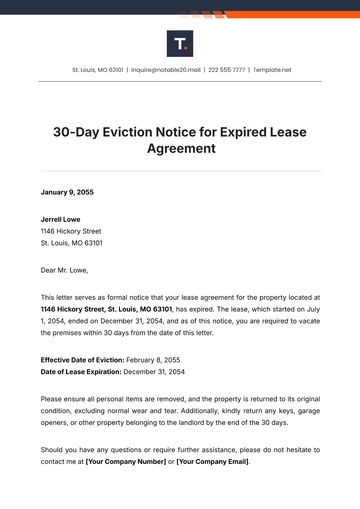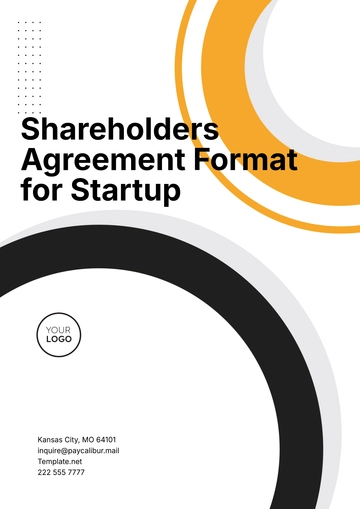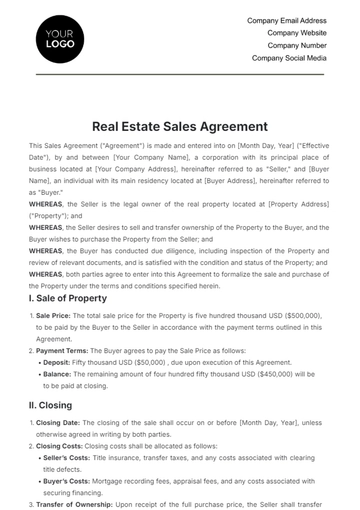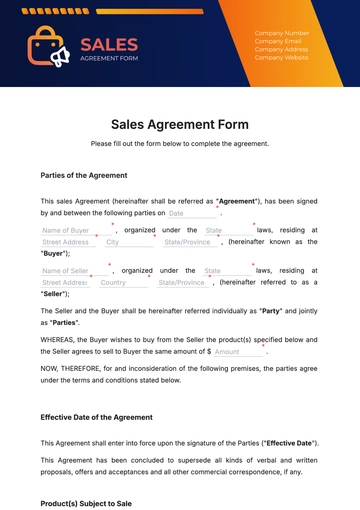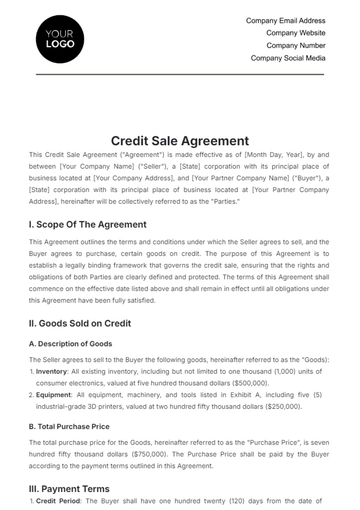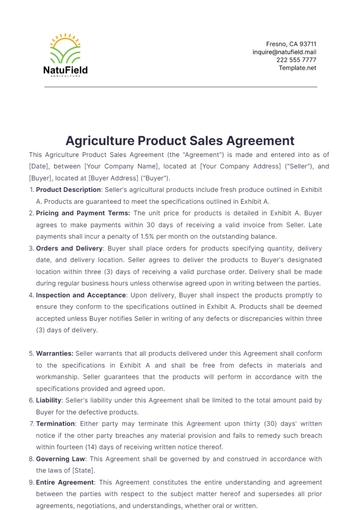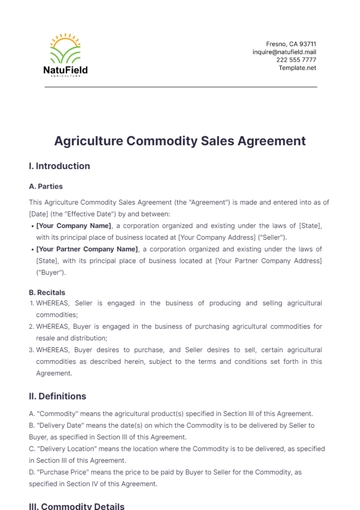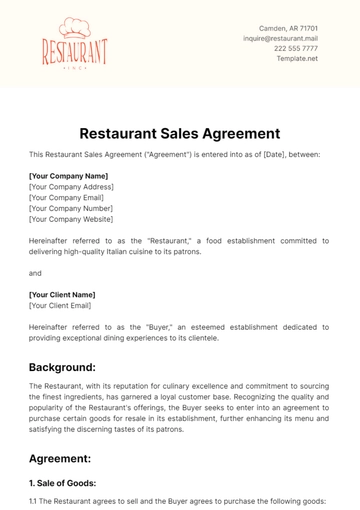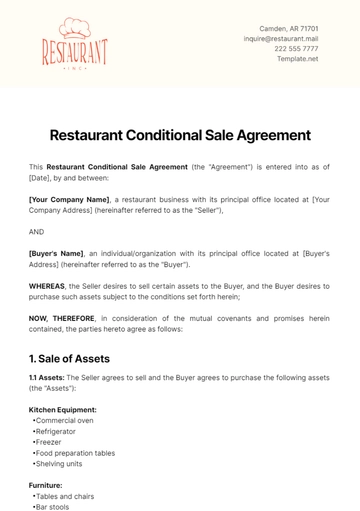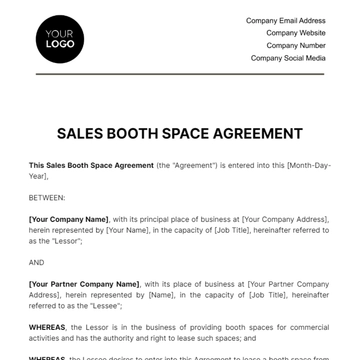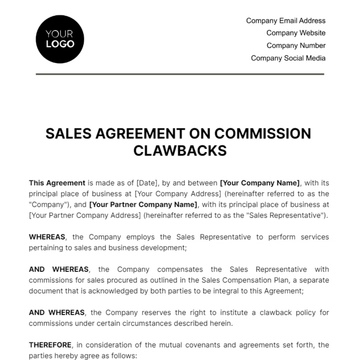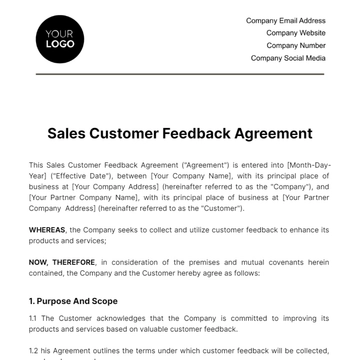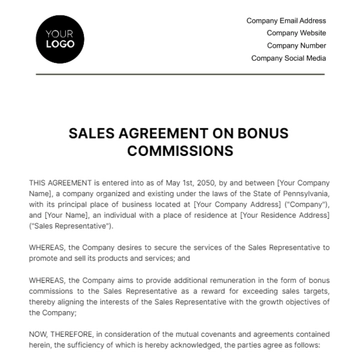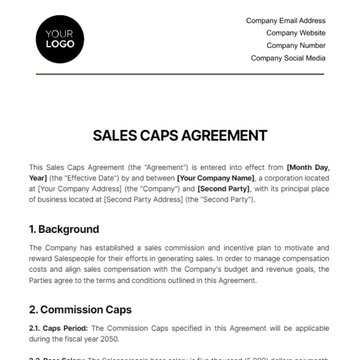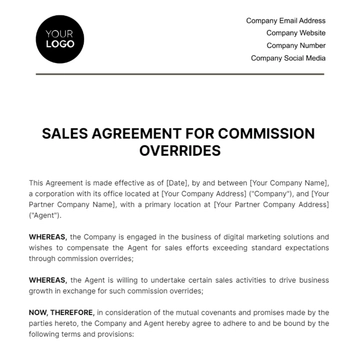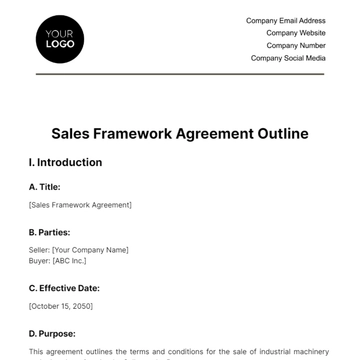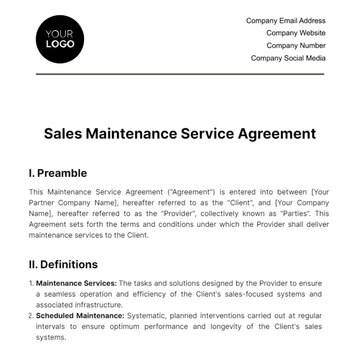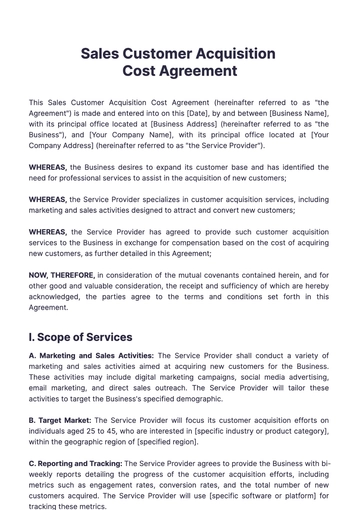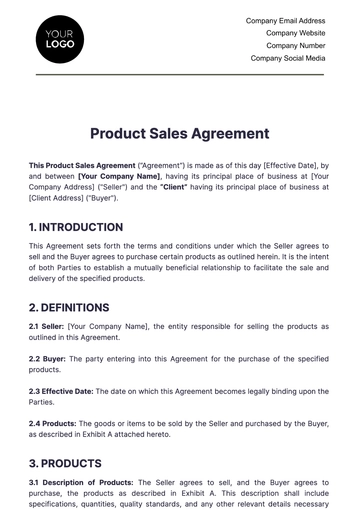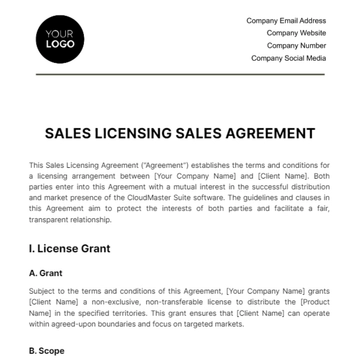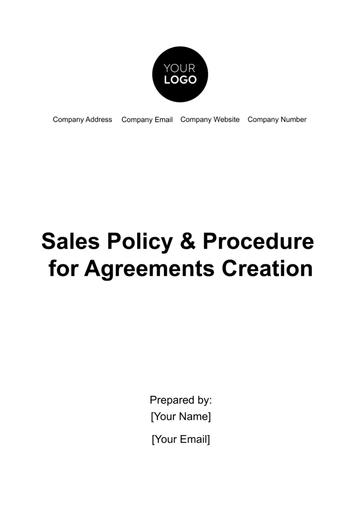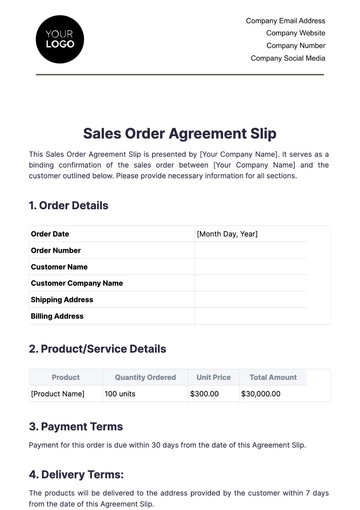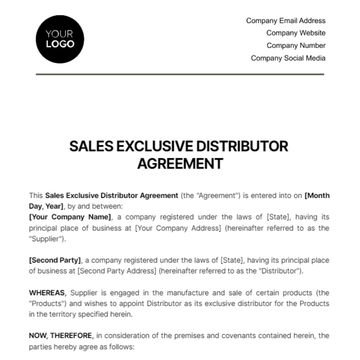Free Sales Policy & Procedure for Agreements Creation
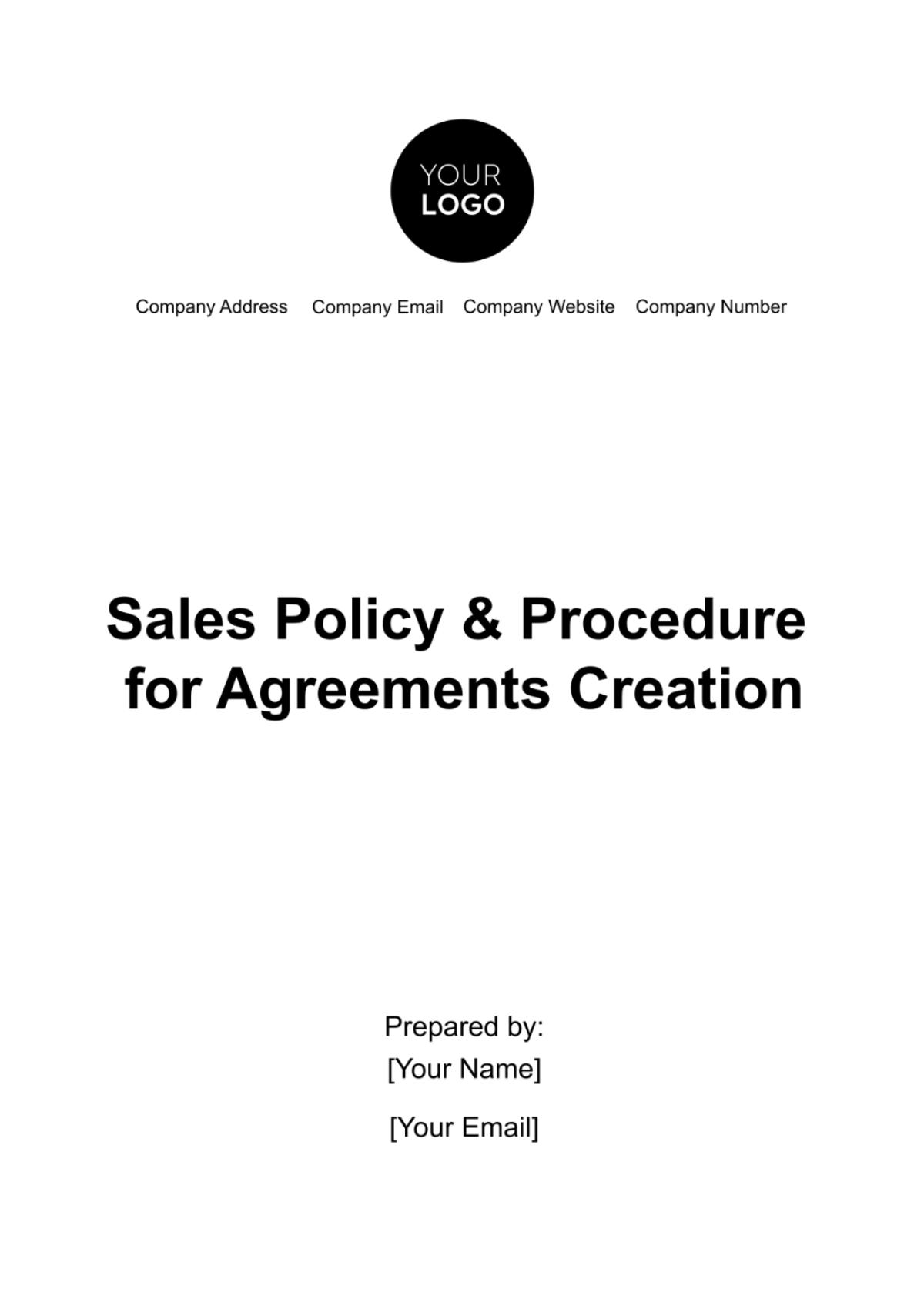
I. Sales Policy & Procedure for Agreements Creation
A. Introduction
Purpose
The purpose of this Sales Policy & Procedure for Agreements Creation is to establish a standardized process for the creation, review, and approval of agreements between [Your Company Name] and its clients or customers. It aims to ensure consistency, accuracy, and legal compliance in all agreements entered into by the company, thereby fostering trust and transparency in client relationships.
Scope
This policy applies to all sales representatives, sales managers, legal department personnel, and any other employees involved in the creation of agreements with clients or customers on behalf of [Your Company Name]. It encompasses all types of agreements, including but not limited to sales contracts, service agreements, and licensing agreements.
Additionally, this policy extends to agreements made with vendors, partners, or any third parties where [Your Company Name] is a contracting party.
B. Agreement Creation Process
Request Initiation
1.1 When a client expresses interest in purchasing [Your Company Name]'s products or services, the sales representative initiates the agreement creation process by capturing relevant details such as the client's name, contact information, and specific requirements.
1.2 The sales representative then communicates the client's request to the sales manager for further evaluation and assignment.
Documentation Gathering
2.1 Upon receiving the client's request, the assigned sales representative is responsible for gathering all necessary documentation to facilitate the agreement creation process. This includes collecting information such as:
Client's company details, including legal name and address
Contact information for the client's authorized representative
Details of the products or services requested by the client
Pricing information, including any discounts or special offers
Terms and conditions of the proposed agreement
2.2 The sales representative may collaborate with other departments, such as product management or finance, to obtain accurate and up-to-date information relevant to the agreement.
2.3 All documentation gathered must be stored securely and made readily accessible to authorized personnel involved in the agreement creation process.
C. Agreement Drafting
Legal Compliance Assessment
1.1 The sales representative forwards the gathered documentation to the legal department for a comprehensive assessment of legal compliance.
1.2 The legal department evaluates the proposed terms and conditions, ensuring alignment with regulatory requirements and [Your Company Name]'s policies.
Drafting Process
2.1 Based on the legal department's assessment, the legal team drafts the agreement using standard templates and language approved by [Your Company Name].
2.2 Any deviations from standard templates require explicit approval from the legal department to mitigate legal risks and ensure consistency in contractual terms.
2.3 The legal department collaborates with the sales representative to incorporate any specific client requirements or negotiated terms into the agreement draft.
II. Agreement Creation Process
A. Request Initiation
Client Inquiry Handling
1.1 When a potential client expresses interest in [Your Company Name]'s products or services, the initial point of contact may occur through various channels, including phone calls, emails, website inquiries, or in-person meetings.
1.2 Sales representatives are trained to promptly respond to client inquiries in a professional and courteous manner, gathering essential information to initiate the agreement creation process.
Assessment of Client Needs
2.1 Upon receiving a client inquiry, the assigned sales representative conducts a thorough assessment of the client's needs and requirements.
2.2 This assessment involves active listening to understand the client's business objectives, challenges, and specific preferences regarding [Your Company Name]'s offerings.
2.3 Sales representatives may utilize standardized questionnaires or consultation scripts to gather comprehensive information from the client.
Preliminary Qualification
3.1 After assessing the client's needs, the sales representative conducts a preliminary qualification to determine the feasibility of meeting the client's requirements.
3.2 Factors considered during qualification may include the client's industry, budget, timeline, and alignment with [Your Company Name]'s target market and capabilities.
3.3 If the client's needs align with [Your Company Name]'s offerings and capabilities, the sales representative proceeds to initiate the agreement creation process. Otherwise, the representative may provide alternative solutions or refer the client to appropriate resources.
B. Documentation Gathering
Initial Client Information Collection
1.1 Once the client's needs are identified and preliminary qualification is successful, the sales representative initiates the documentation gathering process.
1.2 The sales representative collects basic client information, including the client's company name, legal entity type, industry sector, and primary contact details.
Detailed Requirements Assessment
2.1 Following the collection of basic client information, the sales representative conducts a detailed assessment of the client's specific requirements.
2.2 This assessment involves gathering detailed information about the products or services requested by the client, including quantity, specifications, customization requirements, and any special considerations.
2.3 Sales representatives may utilize standardized forms, checklists, or CRM systems to systematically capture and organize client requirements.
Pricing and Financial Considerations
3.1 In addition to gathering product or service requirements, the sales representative collects pricing and financial information relevant to the proposed agreement.
3.2 This includes determining pricing structures, negotiating discounts or promotions, and identifying any applicable taxes, fees, or payment terms.
3.3 Sales representatives collaborate with finance or pricing departments to ensure accuracy and consistency in pricing and financial considerations.
Terms and Conditions Review
4.1 As part of the documentation gathering process, the sales representative reviews [Your Company Name]'s standard terms and conditions relevant to the proposed agreement.
4.2 The sales representative ensures that the client is aware of and agrees to [Your Company Name]'s standard terms and conditions, addressing any questions or concerns raised by the client.
4.3 Any deviations from standard terms and conditions require approval from relevant stakeholders, such as the legal department or senior management.
Documentation Organization and Storage
5.1 Throughout the documentation gathering process, the sales representative maintains meticulous records of all client interactions, communications, and gathered information.
5.2 Documentation is securely stored in [Your Company Name]'s CRM system or document management platform, ensuring accessibility, confidentiality, and compliance with data protection regulations.
5.3 Proper documentation organization facilitates efficient retrieval and reference of client information during subsequent stages of the agreement creation process.
III. Agreement Drafting
A. Legal Compliance Assessment
Review of Applicable Laws and Regulations
1.1 The legal department conducts a thorough review of relevant laws, regulations, and industry standards applicable to the proposed agreement.
1.2 This review ensures that the agreement complies with all legal requirements and mitigates the risk of potential legal disputes or liabilities.
Risk Assessment
2.1 Legal experts assess the potential risks associated with the proposed agreement, considering factors such as contractual obligations, indemnification clauses, intellectual property rights, and dispute resolution mechanisms.
2.2 Risk assessment aims to identify and address potential legal vulnerabilities, ensuring that [Your Company Name]'s interests are adequately protected.
Compliance Verification
3.1 The legal department verifies compliance with internal policies, industry standards, and any contractual obligations with third parties.
3.2 This verification process ensures consistency with [Your Company Name]'s corporate governance principles, ethical standards, and commitment to regulatory compliance.
Customization and Tailoring
4.1 Based on the legal compliance assessment, the legal team customizes the agreement to meet the specific needs and preferences of the client, while ensuring alignment with [Your Company Name]'s standard contractual frameworks.
4.2 Customization may involve modifying clauses, adding provisions, or negotiating terms to accommodate unique requirements or preferences expressed by the client.
B. Drafting Process
Template Utilization
1.1 The legal department utilizes standardized agreement templates approved by [Your Company Name]'s management and legal counsel.
1.2 Standard templates serve as a foundation for agreement drafting, providing consistent language, structure, and formatting across different types of agreements.
Language Clarity and Precision
2.1 Legal experts employ clear, precise, and unambiguous language in drafting the agreement to ensure mutual understanding and enforceability of contractual terms.
2.2 Complex legal terminology is explained in layman's terms where necessary, enhancing transparency and minimizing the risk of misinterpretation.
Comprehensive Coverage
3.1 The agreement draft comprehensively addresses all essential aspects of the contractual relationship between [Your Company Name] and the client.
3.2 Key areas covered include but are not limited to:
Scope of products or services
Delivery terms and timelines
Pricing and payment terms
Warranties and guarantees
Intellectual property rights
Confidentiality and data protection
Termination and dispute resolution mechanisms
Revision and Review
4.1 Drafted agreements undergo multiple rounds of revision and review by legal experts to ensure accuracy, completeness, and consistency.
4.2 Any discrepancies or ambiguities identified during the review process are promptly addressed and resolved to achieve a final agreement draft that meets [Your Company Name]'s standards and objectives.
4.3 The legal department collaborates closely with the sales representative and relevant stakeholders to incorporate any client-specific requirements or negotiated terms into the agreement draft.
IV. Review and Approval
A. Internal Review
Sales Manager Review
1.1 Upon completion of the agreement draft, it is submitted to the sales manager for internal review and approval.
1.2 The sales manager assesses the agreement for alignment with the client's requirements, pricing accuracy, and adherence to internal policies and procedures.
1.3 Any discrepancies or concerns identified during the review are communicated to the legal department for resolution.
Cross-Functional Collaboration
2.1 The sales manager collaborates with other relevant departments, such as finance, operations, or product management, to ensure alignment of the agreement with cross-functional objectives and requirements.
2.2 Cross-functional collaboration facilitates comprehensive review and validation of the agreement draft, addressing any potential issues or gaps from diverse perspectives.
B. Legal Department Approval
Final Legal Review
1.1 After addressing any feedback or concerns raised during internal review, the agreement draft undergoes a final legal review by the legal department.
1.2 Legal experts verify the accuracy of legal language, assess the agreement's compliance with applicable laws and regulations, and confirm alignment with [Your Company Name]'s corporate standards and policies.
Approval Process
2.1 Upon completion of the legal review, the agreement draft is submitted to the legal department's designated approver for final approval.
2.2 Approval is granted only after ensuring that all legal and regulatory requirements are met, and any outstanding issues or concerns are satisfactorily addressed.
2.3 Once approved by the legal department, the agreement draft is deemed ready for client review and signature, marking the final stage of the agreement creation process.
V. Client Review
A. Agreement Submission
Delivery to Client
1.1 After receiving final approval from the legal department, the agreement is promptly delivered to the client for review and signature.
1.2 The sales representative ensures timely and secure delivery of the agreement to the client via the designated communication channel, such as email, secure file transfer, or postal mail.
Accompanying Documentation
2.1 Along with the agreement, the sales representative may provide supplementary documentation or explanatory materials to assist the client in understanding the terms and conditions of the proposed agreement.
2.2 Supplementary materials may include pricing schedules, product specifications, service level agreements, or any other relevant information to facilitate the client's review process.
B. Client Consultation
Clarification of Terms
1.1 Upon receiving the agreement, the client may seek clarification on specific terms, conditions, or provisions outlined in the document.
1.2 The sales representative promptly addresses any inquiries or concerns raised by the client, providing clear and accurate explanations to ensure the client's understanding of the agreement.
Negotiation and Amendments
2.1 If the client identifies any discrepancies, discrepancies, or proposed modifications to the agreement, the sales representative facilitates negotiation and amendment discussions.
2.2 Negotiations may involve revising pricing terms, adjusting delivery schedules, modifying service levels, or accommodating other client-specific requests within the bounds of [Your Company Name]'s policies and capabilities.
2.3 The sales representative collaborates with internal stakeholders, including the legal department and relevant department heads, to evaluate proposed amendments and ensure alignment with [Your Company Name]'s interests.
C. Finalization and Approval
Agreement Finalization
1.1 Upon resolution of any negotiation points or requested amendments, the agreement is finalized with mutual agreement between [Your Company Name] and the client.
1.2 Finalization may involve updating the agreement document to reflect agreed-upon amendments or modifications.
Client Signature
2.1 Once all parties are satisfied with the terms and conditions, the client signs the agreement document to indicate acceptance and agreement to the terms outlined therein.
2.2 The sales representative coordinates the signing process, ensuring that all necessary signatures and approvals are obtained from authorized representatives of the client organization.
VI. Execution and Record Keeping
A. Execution of Agreement
Binding Agreement
1.1 Upon receipt of the client's signed agreement, the document becomes legally binding and enforceable between [Your Company Name] and the client.
1.2 The agreement establishes the rights, obligations, and responsibilities of both parties with respect to the products or services outlined therein.
Acknowledgment of Agreement
2.1 The sales representative acknowledges receipt of the signed agreement and communicates acceptance to the client, confirming the commencement of contractual obligations.
2.2 Any additional actions required to fulfill the terms of the agreement are initiated promptly to ensure timely delivery of products or services to the client.
B. Record Keeping
Document Retention
1.1 [Your Company Name] maintains accurate records of all executed agreements, including signed copies and any associated correspondence or amendments.
1.2 Executed agreements are stored securely in [Your Company Name]'s document management system or CRM platform for easy retrieval and reference.
Compliance with Retention Policies
2.1 All executed agreements are retained in accordance with [Your Company Name]'s document retention policies and applicable legal requirements.
2.2 Document retention periods are established based on the nature of the agreement, regulatory obligations, and business needs, ensuring compliance with data protection and privacy regulations.
VII. Compliance and Quality Assurance
A. Adherence to Policy
Policy Implementation
1.1 All personnel involved in the agreement creation process are required to adhere strictly to the policies and procedures outlined in this Sales Policy & Procedure for Agreements Creation.
1.2 Compliance with policy guidelines ensures consistency, accuracy, and legal compliance in all agreements entered into by [Your Company Name], safeguarding the company's interests and reputation.
Training and Awareness
2.1 Ongoing training programs are conducted to educate sales representatives, managers, and other personnel on the policies and procedures governing agreement creation.
2.2 Training sessions cover topics such as legal compliance, document handling, negotiation skills, and client communication, equipping employees with the knowledge and skills necessary to perform their roles effectively.
Performance Evaluation
3.1 Compliance with policy guidelines is incorporated into performance evaluations for sales personnel and managers, with adherence to policy serving as a key performance indicator.
3.2 Regular performance reviews provide opportunities for feedback, coaching, and reinforcement of policy compliance expectations, driving continuous improvement in agreement creation processes.
B. Quality Assurance Measures
Document Review and Verification
1.1 Prior to submission for client review, all agreement documents undergo thorough review and verification by designated personnel, including sales managers and the legal department.
1.2 Document review ensures accuracy, completeness, and compliance with internal policies, legal requirements, and client specifications.
Quality Control Checks
2.1 Quality control checks are conducted at various stages of the agreement creation process to identify and rectify any errors, inconsistencies, or discrepancies.
2.2 Quality control measures may include cross-referencing client requirements with documented specifications, verifying pricing calculations, and validating legal compliance of contractual terms.
Continuous Improvement Initiatives
3.1 [Your Company Name] is committed to continuous improvement in its agreement creation processes, with a focus on enhancing efficiency, accuracy, and customer satisfaction.
3.2 Feedback mechanisms are established to solicit input from stakeholders, including sales personnel, clients, and legal experts, to identify areas for improvement and implement corrective actions as needed.
VIII. Policy Review and Updates
A. Regular Review
Annual Policy Review
1.1 This Sales Policy & Procedure for Agreements Creation undergoes an annual review to ensure its continued relevance, effectiveness, and alignment with [Your Company Name]'s strategic objectives and regulatory requirements.
1.2 The review process involves soliciting feedback from key stakeholders, assessing policy performance metrics, and evaluating changes in legal and industry standards.
Policy Revision
2.1 Based on the outcomes of the annual review, revisions or updates may be made to the policy to address emerging issues, incorporate best practices, or enhance clarity and comprehensiveness.
2.2 Policy revisions are communicated to all relevant personnel through official channels, such as company-wide announcements, training sessions, or updates to the policy documentation.
B. Ad Hoc Updates
Immediate Policy Updates
1.1 In response to significant changes in laws, regulations, or business circumstances, ad hoc updates to the policy may be necessary to ensure timely compliance and risk mitigation.
1.2 Immediate updates are communicated promptly to all affected personnel to ensure awareness and adherence to the revised policy guidelines.
Notification and Training
2.1 Notification of policy updates is accompanied by targeted training sessions or communication initiatives to educate personnel on the changes and their implications for their roles and responsibilities.
2.2 Training materials and resources are provided to support employees in understanding and implementing the updated policy guidelines effectively.
- 100% Customizable, free editor
- Access 1 Million+ Templates, photo’s & graphics
- Download or share as a template
- Click and replace photos, graphics, text, backgrounds
- Resize, crop, AI write & more
- Access advanced editor
Craft and manage agreements seamlessly with our Sales Policy & Procedure for Agreements Creation Template from Template.net. This editable and customizable document outlines the step-by-step process for creating agreements, ensuring consistency and accuracy. Tailor it to your company's specific needs using our Ai Editor Tool, streamlining the agreement creation process for enhanced efficiency and compliance.
You may also like
- Lease Agreement
- Non Compete Agreement
- Rental Agreement
- Prenuptial Agreement
- Non Disclosure Agreement
- Operating Agreement
- Hold Harmless Agreement
- LLC Operating Agreement
- Arbitration Agreement
- Purchase Agreement
- Residential Lease Agreement
- Executive Agreement
- Confidentiality Agreement
- Contractor Agreement
- Partnership Agreement
- Postnuptial Agreement
- Collective Bargaining Agreement
- Loan Agreement
- Roommate Agreement
- Commercial Lease Agreement
- Separation Agreement
- Cohabitation Agreement
- Room Rental Agreement
- Child Custody Agreement
- Employee Agreement
- License Agreements
- Settlement Agreement
- Joint Venture Agreement
- Indemnity Agreement
- Subordination Agreement
- Sales Agreement
- Agreements Between Two Parties
- Business Agreement
- Real Estate Agreement
- HR Agreement
- Service Agreement
- Property Agreement
- Agreement Letter
- Restaurant Agreement
- Construction Agreement
- Finance Agreement
- Marketing Agreement
- Payment Agreement
- Investment Agreement
- Management Agreement
- Nonprofit Agreement
- Software Agreement
- Startup Agreement
- Agency Agreement
- Copyright Agreement
- Collaboration Agreement
- Reseller Agreement
- Car Rental Agreement
- Cleaning Services Agreement
- Consultant Agreement
- Deed Agreement
- Car Agreement
- Equipment Agreement
- Shares Agreement
- Data Sharing Agreement
- Advertising Agreement
- School Agreement
- Franchise Agreement
- Event Agreement
- Travel Agency Agreement
- Vehicle Agreement
- Board Resolution Agreement
- Land Agreement
- Binding Agreement
- Tenancy Agreement
- Exclusive Agreement
- Development Agreement
- Assignment Agreement
- Design Agreement
- Equity Agreement
- Mortgage Agreement
- Purchase and Sale Agreement
- Shareholder Agreement
- Vendor Agreement
- Royalty Agreement
- Vehicle Lease Agreement
- Hotel Agreement
- Tenant Agreement
- Artist Agreement
- Commission Agreement
- Consignment Agreement
- Debt Agreement
- Recruitment Agreement
- Training Agreement
- Transfer Agreement
- Apprenticeship Agreement
- IT and Software Agreement
- Referral Agreement
- Resolution Agreement
- Waiver Agreement
- Consent Agreement
- Partner Agreement
- Social Media Agreement
- Customer Agreement
- Credit Agreement
- Supply Agreement
- Agent Agreement
- Brand Agreement
- Law Firm Agreement
- Maintenance Agreement
- Mutual Agreement
- Retail Agreement
- Deposit Agreement
- Land Purchase Agreement
- Nursing Home Agreement
- Supplier Agreement
- Buy Sell Agreement
- Child Support Agreement
- Landlord Agreement
- Payment Plan Agreement
- Release Agreement
- Research Agreement
- Sponsorship Agreement
- Buyout Agreement
- Equipment Rental Agreement
- Farm Agreement
- Manufacturing Agreement
- Strategic Agreement
- Termination of Lease Agreement
- Compliance Agreement
- Family Agreement
- Interior Design Agreement
- Ownership Agreement
- Residential Lease Agreement
- Retainer Agreement
- Trade Agreement
- University Agreement
- Broker Agreement
- Dissolution Agreement
- Funding Agreement
- Hosting Agreement
- Investor Agreement
- Memorandum of Agreement
- Advisory Agreement
- Affiliate Agreement
- Freelancer Agreement
- Grant Agreement
- Master Service Agreement
- Parking Agreement
- Subscription Agreement
- Trust Agreement
- Cancellation Agreement
- Horse Agreement
- Influencer Agreement
- Membership Agreement
- Vacation Rental Agreement
- Wholesale Agreement
- Author Agreement
- Distributor Agreement
- Exchange Agreement
- Food Agreement
- Guarantee Agreement
- Installment Agreement
- Internship Agreement
- Music Agreement
- Severance Agreement
- Software Development Agreement
- Storage Agreement
- Facility Agreement
- Intercompany Agreement
- Lending Agreement
- Lodger Agreement
- Outsourcing Services Agreement
- Usage Agreement
- Assurance Agreement
- Photography Agreement
- Profit Sharing Agreement
- Relationship Agreement
- Rent To Own Agreement
- Repayment Agreement
- Volunteer Agreement
- Co Parenting Agreement
- HVAC Agreement
- Lawn Care Agreement
- SAAS Agreement
- Work from Home Agreement
- Coaching Agreement
- Protection Agreement
- Security Agreement
- Repair Agreement
- Agreements License
